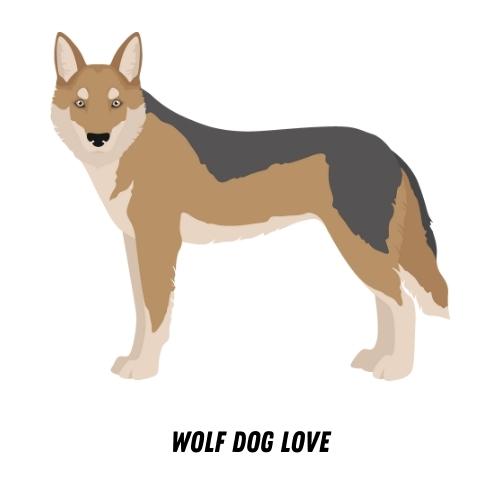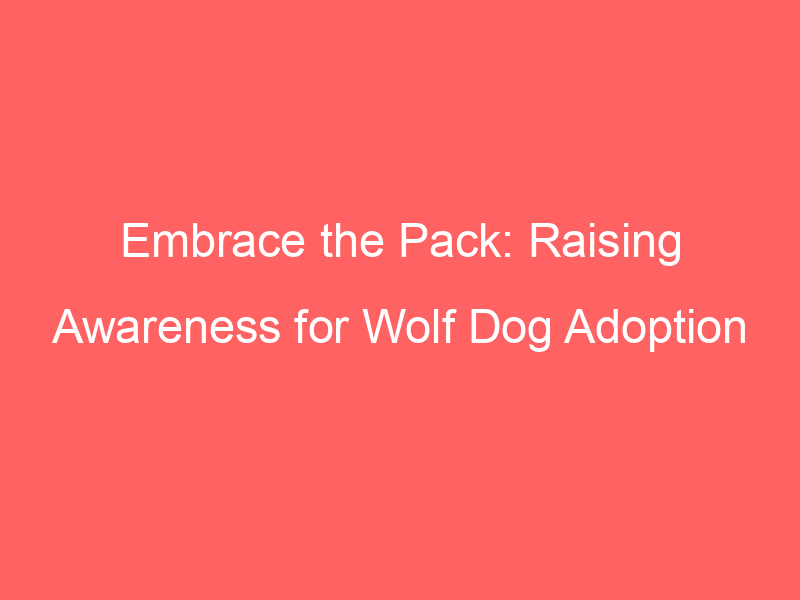Introduction to Wolf Dog Behavior
Wolf dogs, a unique blend of domestic dog and wild wolf, exhibit fascinating behaviors that are a mix of both their canine and lupine heritage. Understanding these behaviors can help us better appreciate these magnificent creatures and debunk common misconceptions about them.
- Understanding the unique characteristics of wolf dog behavior
- Common misconceptions about wolf dog behavior
Wolf dogs are known for their intelligence, independence, and strong pack mentality. Unlike domestic dogs, wolf dogs are more likely to exhibit behaviors such as digging, climbing, and roaming due to their wild ancestry. They are also known for their vocalizations, which can include howling, growling, and whimpering, much like their wolf ancestors. Wolf dogs are also highly territorial and may mark their territory more frequently than domestic dogs.
Many people believe that wolf dogs are simply wild wolves that can be tamed and kept as pets. This is a common misconception. While wolf dogs do share some behaviors with their wolf ancestors, they are not wild animals and should not be treated as such. They require the same care, training, and socialization as any other dog breed. Another misconception is that all wolf dogs are aggressive. While wolf dogs can be more assertive than some dog breeds, they are not inherently aggressive. Aggression in wolf dogs, like in any other dog, is often a result of poor socialization, lack of training, or mistreatment.
In conclusion, understanding the unique behaviors of wolf dogs and debunking common misconceptions about them can help us better appreciate these fascinating creatures. As with any dog breed, proper care, training, and socialization are key to ensuring a happy and healthy relationship with a wolf dog.
Understanding Canine Communication
Communication is a fundamental aspect of any relationship, and the bond between humans and dogs is no exception. Understanding canine communication is crucial for a harmonious coexistence with our furry friends. Let’s delve into the basics of canine communication techniques.
Basics of Canine Communication Techniques
Canine communication is a complex system of signals that dogs use to express their feelings, intentions, and responses. It involves a combination of vocalizations, body language, and facial expressions. Here are some key points to consider:
- Importance of understanding canine communication
- Common canine communication signals
Understanding canine communication is essential for several reasons. It helps us interpret what our dogs are trying to tell us, thereby preventing misunderstandings that could lead to behavioral problems. It also allows us to respond appropriately to their needs, enhancing their well-being and our relationship with them.
Dogs communicate primarily through body language. Some common signals include wagging tails, raised hackles, bared teeth, and specific postures. For instance, a relaxed dog may have a loose, wagging tail, while an aggressive dog may have raised hackles and bared teeth. Understanding these signals can help us better interpret our dogs’ emotions and intentions.
In conclusion, understanding canine communication is not just about interpreting signals, but also about responding appropriately. By learning to ‘speak dog’, we can build a stronger, more understanding relationship with our canine companions.
Wolf Dog Communication Methods
Wolf dogs, a unique blend of domestic dog and wild wolf, have a fascinating way of communicating. They use a combination of body language and vocalization to express their feelings and intentions. Let’s delve into these two main methods of communication.
- Interpreting Wolf Dog Body Language
Just like humans, wolf dogs use body language to communicate. Understanding their body language can provide valuable insights into their mood and intentions. Here are a few key signals to look out for:
| Body Signal | Meaning |
|---|---|
| Ears Forward | This usually indicates interest or alertness. |
| Tail Wagging | While often associated with happiness, tail wagging can also signal nervousness or excitement. |
| Rolling Over | This is a submissive gesture, often used to show respect to a more dominant dog. |
Remember, context is crucial when interpreting body language. The same signal can mean different things in different situations.
- Understanding Wolf Dog Vocalization
Wolf dogs also use a range of vocal sounds to communicate. These can vary from barks and howls to whines and growls. Here’s what some of these sounds typically mean:
| Vocal Sound | Meaning |
|---|---|
| Bark | Often used to alert others of potential danger or to get attention. |
| Howl | Commonly used for long-distance communication, such as to locate pack members or claim territory. |
| Whine | Usually indicates submission, appeasement, or a desire for attention. |
Understanding these vocal signals can help you better communicate with your wolf dog and respond to their needs.
In conclusion, interpreting wolf dog body language and understanding their vocalization are key to effective communication with these unique animals. By paying close attention to these signals, you can build a stronger bond with your wolf dog and ensure their well-being.
Decoding Wolf Dog Communication Signals
One of the most fascinating aspects of wolf dogs is their unique communication signals. These signals are a blend of behaviors inherited from their wolf and dog ancestors. Understanding these signals can help us better understand and interact with these magnificent creatures.
Wolf Dog Body Language
Body language is a key part of wolf dog communication. It includes a variety of signals that wolf dogs use to express their feelings, intentions, and reactions to their environment.
- Key elements of wolf dog body language
- Examples of wolf dog body language and their interpretations
Wolf dogs use their entire body to communicate. This includes their ears, tail, eyes, and posture. For instance, a wolf dog with its ears pinned back and tail tucked between its legs is likely feeling scared or submissive. On the other hand, a wolf dog with its tail held high and ears forward is likely feeling confident and alert.
Let’s look at some specific examples of wolf dog body language and what they might mean:
| Body Language | Interpretation |
|---|---|
| Ears pinned back | Fear or submission |
| Tail held high | Confidence or alertness |
| Body lowered to the ground | Submission or fear |
| Body standing tall | Confidence or dominance |
It’s important to note that context is key when interpreting wolf dog body language. The same signal can mean different things in different situations. Therefore, it’s crucial to consider the overall situation and the wolf dog’s other behaviors when interpreting their body language.
Understanding wolf dog body language can greatly enhance our interactions with these animals. It can help us recognize when they’re feeling comfortable, when they’re scared, and when they’re trying to communicate something important. This understanding can lead to stronger, more positive relationships with our wolf dog companions.
Interpreting Wolf Dog Sounds
Wolf dogs, a unique blend of domestic dog and wild wolf, communicate through a variety of sounds. Understanding these sounds can help us better understand their needs and emotions. Let’s delve into the different types of wolf dog sounds and how to interpret them.
- Understanding the different types of wolf dog sounds
Wolf dogs make a variety of sounds to communicate. These can be broadly categorized into four types:
| Type of Sound | Description |
|---|---|
| Barks | Short, sharp sounds often used to alert or warn others. |
| Howls | Long, drawn-out sounds used to communicate over long distances or express loneliness. |
| Growls | Low, rumbling sounds usually indicating aggression or discomfort. |
| Whines | High-pitched sounds often expressing submission, pain, or a desire for attention. |
Each of these sounds carries a different message, and understanding them can greatly enhance our relationship with these fascinating creatures.
- How to interpret these sounds
Interpreting wolf dog sounds involves careful listening and observation. Here are some tips:
- Barks are often a sign of alertness. If your wolf dog is barking, it may be because they’ve noticed something unusual in their environment.
- Howls can be a sign of loneliness or a call to other pack members. If your wolf dog is howling a lot when left alone, it might be feeling lonely.
- Growls usually signal aggression or discomfort. If your wolf dog is growling, it may be best to give it some space.
- Whines can indicate a variety of things, from submission to a desire for attention. Pay attention to the context in which the whining occurs to understand its meaning.
Remember, every wolf dog is unique and may use sounds differently. The key is to spend time with your wolf dog, observe their behavior, and learn their unique communication style.
Wolf Dog Interaction
Wolf dogs, a unique blend of domestic dog and wild wolf, are fascinating creatures. Their interaction with humans and other canines can be quite different from other breeds. Let’s delve into the dynamics of these interactions.
Wolf Dog Interaction with Humans
Understanding the dynamics of wolf dog-human interaction is crucial for anyone considering bringing a wolf dog into their home. Let’s explore this topic further.
- Understanding the dynamics of wolf dog-human interaction
- Case study: Successful wolf dog-human interaction
Wolf dogs are not your average pet. They possess a wild instinct from their wolf heritage, which can make their behavior unpredictable at times. They require a lot of patience, understanding, and training to coexist peacefully with humans. They are often wary of strangers and can be protective of their human family. However, with proper socialization and training, they can form strong bonds with their human companions.
Consider the case of Max, a wolf dog who was adopted by the Smith family. Initially, Max was wary and aloof. However, with consistent training and socialization, he gradually warmed up to his human family. He learned to understand and respond to basic commands and even developed a playful side. This case demonstrates that with patience, understanding, and proper training, successful wolf dog-human interaction is possible.
Understanding a wolf dog’s needs and behavior is key to a successful interaction. It’s important to remember that every wolf dog is unique and may require different approaches. However, with patience and understanding, a strong bond can be formed between a wolf dog and its human family.
Wolf Dog Interaction with Other Canines
Wolf dogs are unique creatures, a blend of wild and domestic traits. Understanding their interaction with other canines can be a fascinating study. Let’s delve into the dynamics of these interactions and explore a case study of successful wolf dog-canine interaction.
- Understanding the dynamics of wolf dog-canine interaction
Wolf dogs carry the genetic traits of both wolves and domestic dogs. This combination can lead to a complex set of behaviors when interacting with other canines. They may exhibit dominance, submission, playfulness, or aggression, depending on the situation.
Wolf dogs often use body language to communicate. For example, a raised tail and ears signify dominance, while a lowered tail and flattened ears indicate submission. Understanding these signals can help in predicting and managing their interactions with other dogs.
However, it’s important to note that each wolf dog is an individual with its own personality and temperament. Therefore, their interactions with other canines can vary widely.
- Case study: Successful wolf dog-canine interaction
Consider the case of Max, a wolf dog, and Bella, a golden retriever. Initially, Max displayed dominance towards Bella. However, with careful management and positive reinforcement, Max learned to interact peacefully with Bella.
| Key Steps in Max and Bella’s Interaction |
|---|
| 1. Slow and supervised introductions |
| 2. Positive reinforcement for peaceful interactions |
| 3. Gradual increase in interaction time |
Over time, Max and Bella developed a strong bond. This case study shows that with patience, understanding, and the right approach, wolf dogs can successfully interact with other canines.
Remember, understanding and managing wolf dog interactions with other canines requires knowledge, patience, and consistency. Always consult with a professional if you’re unsure about your wolf dog’s behavior.
Key Takeaways: Understanding Wolf Dog Behavior and Communication
As we conclude our exploration of wolf dog behavior and communication, it’s important to highlight the key insights we’ve gathered. Understanding these unique creatures is not only fascinating but also crucial for anyone who interacts with them, whether as a pet owner, a trainer, or an animal enthusiast.
- Importance of understanding wolf dog behavior and communication
Wolf dogs are a unique blend of domestic dog and wild wolf traits. This combination results in a complex communication style that can be challenging to understand. However, gaining this understanding is vital. It allows us to interact with these animals in a respectful and safe manner, ensuring their well-being and ours. Moreover, understanding wolf dog behavior can help prevent misunderstandings that could lead to unnecessary fear or aggression.
- Practical tips for interpreting wolf dog signals
Interpreting wolf dog signals requires patience and keen observation. Here are some practical tips:
- Pay attention to body language: Wolf dogs use their entire body to communicate. Watch for changes in posture, tail position, ear movement, and facial expressions.
- Listen to vocalizations: Wolf dogs can growl, howl, whine, and bark to express various emotions. Each sound has a different meaning, so listen carefully.
- Observe behavior patterns: Regular observation can help you understand your wolf dog’s normal behavior. Any sudden changes could indicate stress, fear, or illness.
Remember, every wolf dog is an individual with its own personality and communication style. What works for one may not work for another. So, keep an open mind and be willing to adapt your approach as needed.
In conclusion, understanding wolf dog behavior and communication is a rewarding journey that deepens our connection with these remarkable animals. It requires patience, observation, and a willingness to learn. But the effort is well worth it, leading to a more harmonious and fulfilling relationship with your wolf dog.
Conclusion: A Deeper Understanding of Canine Communication
As we conclude this informative journey into the world of wolf dogs and their communication methods, it’s important to take a moment to reflect on what we’ve learned and why it matters.
- Recap of the importance of understanding canine communication
- Final thoughts on decoding the language of wolf dogs
Understanding canine communication is not just about decoding barks and growls. It’s about building a bridge between two different species and fostering a relationship based on mutual respect and understanding. When we take the time to understand the language of our canine companions, we open up a whole new world of interaction and connection. We’ve seen through various examples and case studies how understanding canine communication can lead to better training outcomes, improved behavior, and a deeper bond between humans and their wolf dog pets.
Decoding the language of wolf dogs is a fascinating journey that requires patience, observation, and a willingness to learn. As we’ve discovered, wolf dogs communicate in a variety of ways – through body language, vocalizations, and even scent. By paying close attention to these signals and responding appropriately, we can better understand our wolf dog companions and meet their needs effectively.
In conclusion, understanding canine communication is a rewarding endeavor that can greatly enhance our relationships with our wolf dog pets. It’s a journey of discovery that can lead to a deeper appreciation of these remarkable animals and their unique ways of communicating. So, let’s continue to learn, observe, and connect with our canine companions in a way that respects and honors their unique language.








